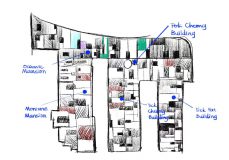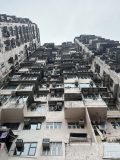With constrained urban space, Hong Kong is related to a crowdy spatial characteristic.
Theme
“The densest spot on earth,” according to Lee Ho-yin, is the Yick Cheong Building (also named as Monster Building) on King’s Road. This topic has been intriguing to me since my first and most striking impression of Hong Kong was its intense popularity, which is intrinsically linked to its crowded housing estates. The incredible number of residential units in the enormous Monster Building served to further emphasize the message conveyed in the video about Hong Kong’s high-density housing estates.
Settings
The Monster Building is a perfect representation of Hong Kong’s renowned urban density. The complex is comprised of five buildings: the Yick Fat Building, the Yick Cheong Building, the Montane Mansion Building, the Oceanic Mansion Building, and the Fook Cheong Building, which connects the other four. Whenever viewed from the top, the buildings are structured in an “M” shape, with two long north-south courtyards and vivid dwellings and outdoor spaces on three of its sides. The nickname “Monster Building” refers to the structure’s gigantic dimensions and remarkable arrangement of residential units.

Situated at one of the building’s courtyards and looking upward, one observes that the towering concrete structures rise on all three sides, leaving only a little, U-shaped space of sky on the top.

With the intention of fitting as many residential units as the building could allow, the building’s exterior is flat, but its interior is irregular to maximize the use of limited urban space. A distinct division is created by coloring each block with different colors, while the color also gives vibrancy and liveliness as the high architecture inhibits sunlight from reaching the platform.


Methodology
This theme was my choice since it captures my initial thoughts about Hong Kong, where the Monster Building comes to mind when I think of the phrase “densely populated,” a complex containing mass housing units. My curiosity about the building’s enormous scale inspired me to investigate what it was intended for. The Monster Building was first constructed in Hong Kong between the 1950s and 1960s, with a large number of units to deal with the population growth that occurred as a result of the influx of refugees from mainland China (Philjake, 2021). Currently, there are 2,243 units in five blocks with 18 floors in height with 6,840 people living in this complex (Verebes, 2021). In order to get an up-close and complete look at the architecture, I recorded and investigated both the exterior and interior structure of the complex in the fieldwork. The extreme utilitarian characteristics of the architecture could be observed.
Filming Techniques and Reflections
Skills of backlighting and composition are applied to capture the remarkable symmetry of the building’s architecture by an upward vision and a rectangular image of sky with four surrounding blocks. While the courtyard is situated in the shadow of the four tall buildings, when shooting at the sky, a dramatic contrast between the courtyard’s shadow and the brightness of the sky is created. This also evokes emotions of misery and depression since the cramped living spaces and a dim and narrow courtyard surrounded oppressive high-density buildings, which made me link to the metaphorical “frog in a well” in Chinese culture. The film also makes use of tilt shots to illustrate the height of buildings and the oppression they bring about since the superposition of vertical and horizontal dimensions contributes to the building’s vast magnitude. The huge scale of the complex is a result of both the horizontal and vertical extensions, where the mass array windows of the apartments indicate the large number of residential units contained in the architecture. The vertical spatial feature has always been a key component in Hong Kong due to limited urban space. The pulling lens is used to focus on a single residential unit of the complex instead of an overall perspective of the enormous building. Even though every residential unit looks the same, each private unit is distinct. This skill provides a comparison of a micro perspective to a macro perspective. Additionally, the exterior and interior of the complex are connected by a match shot. This enables the transition from the exterior’s white wall to the interior’s vibrantly colored walls, giving the audience a clear picture of the entire Monster Building.
The video essay seems to have a lot of depth and is well worth looking into. My investigation into the Monster Building has helped me recognize Hong Kong’s distinctive spatial and social relationships as well as its traditional community that provides residents with an enjoyable way of life. The social interactions and way of life of Hong Kong’s inhabitants are intrinsically connected to the densely populated, tightly packed apartments that form their neighborhoods. However, the other two buildings are the only views that can be seen from the windows, and with decades’ worth of filth, little ventilation, and no discernable vistas, residents may still feel uncomfortable regarding the tightly packed complex.
References:
Dewolf, C. (2019, October 12). Hong Kong’s modern heritage, part VII: The monster building. Zolima City Magazine. https://zolimacitymag.com/hong-kongs-modern-heritage-part-vii-the-monster-building/
Gilmore, S. (2019, October 27). Tower-ING fiction #8: “monster building,” Transformers: Age of extinction (2014), Ghost in the Shell (2017), White Dragon/Strangers (2018). The Vault of Culture. https://www.vaultofculture.com/vault/towering/monsterbuilding
Monster building (Yik Cheong Building). Time Out Hong Kong. (2018, September 17). https://www.timeout.com/hong-kong/attractions/monster-building-yik-cheong-building
Philjake. (2021, February 26). Monster building (Yick Cheong Building) in Hong Kong. The Tower Info Skyscrapers & Urban Adventures. https://thetowerinfo.com/monster-building-hong-kong/
Ugc. (2018, January 24). The Monster Building. Atlas Obscura. https://www.atlasobscura.com/places/quarry-bay-monster-building
Verebes, R. (2021, December 29). The history behind Monster Building, HKS coolest Ig hotspot. The Beat Hong Kong. https://thebeat.asia/hong-kong/nomads/explore/the-history-behind-monster-building-hong-kongs-coolest-instagram-hotspot
Credits: Juan Wei
Juan Wei
3036100181